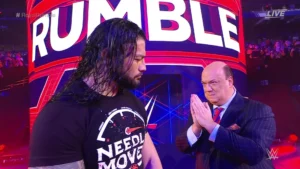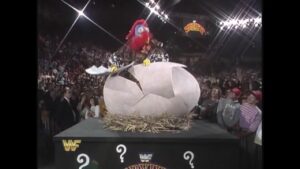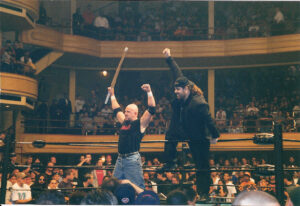Today, seeing some of the indie’s top stars land up in the WWE or NXT, or Ring of Honor, IMPACT Wrestling or New Japan Pro Wrestling (NJPW) is commonplace. In fact, it’s become as guaranteed in pro wrestling life as death and taxes. But it hasn’t always been the phenomenon its become. During the territories of the National Wrestling Alliance (NWA), they were full-fledged territories that all had their top stars. It wasn’t until the 1980s that they became so exclusive between NWA or WWF. In the 1990s, with the fall of the territories, the NWA lost its sizzle and the Big Three – WWF, WCW and ECW – battled and traded roster members. By the time WCW and ECW fell, the top options all faded, and the indies that had been nurturing the bleeding wounds of the body of the NWA began to splinter off, between promoters and wrestlers, and in the early 2000s, the rise of indies like Ring of Honor, Pro Wrestling Guerrilla (PWG), Major League Wrestling (MLW) and TNA/IMPACT Wrestling began to accelerate. TNA was the first to take advantage of the indie wealth, but in 2006 the WWE entered the waters signing CM Punk. The rest is history. But the WWE had briefly dipped its waters into the indies in the late 80s, as the NWA was on its last legs, and the splitting factions, like American Wrestling Association (AWA) and World Class Championship Wrestling (WCCW), were crumbling around themselves. NWA was primarily bought up by World Championship Wrestling (WCW) and the WWF was entering its steroid scandal years – affectionately referred to as The New Generation. Both WCW and WWF needed to restock quickly, and with most of the established stars either already under contract to either one of them – or two jacked up to sign at the moment due to the heat of the steroid scandal – the WWF had to look elsewhere for its young new faces. And one of their first pickups was a scrawny kid from Minnesota known as the Lightning Kid, who would become infamous as 1-2-3 Kid, Syxx and X-Pac. Although now he’s known simply as Sean Waltman.

By the end of the 1980s, the WWF was clearly in the driver’s seat. Vince McMahon Jr. of the WWF and Jim Crockett Jr. of Jim Crockett Promotions were locked in a battle for superiority of the industry and taking the reigns of the next wave of industry change. Both had taken over long time old school promotions from their fathers and had begun to buy up NWA territories and amalgamate them into one national brand. Vince Jr. acquired a crown jewel in the Brisco Brothers’ Georgia Championship Wrestling, as well as the Tunney’s Maple Leaf Wrestling in Toronto and Stu Hart‘s Stampede Wrestling in Calgary. Meanwhile, Crockett Jr. acquired Championship Wrestling From Florida, Championship Wrestling From Georgia, St. Louis Wrestling Club, and Mid South, to unite with his own Mid Atlantic to create a new face of the NWA. AWA and WCCW’s unwillingness to partner until too late – they tried to unite with Jerry Lawler and Jerry Jarrett‘s Continental Wrestling Association (CWA) to failure, although CWA and WCCW would merge into United States Wrestling Association (USWA) – caused their own demise, but McMahon’s early embrace of cable wrestling and the power of syndication gave him the edge. By 1988, Crockett was bankrupt, selling his NWA to Ted Turner which became WCW. His “NWA” was that in name only – the NWA would continue as a governing body long after WCW seceded in the early 90s.

In 1989, a 17-year old youth from Minneapolis began training under the tutelage of the likes of Boris Malenko (Dean’s dad), Eddie Sharkey, and Frank Gotch, He soon began working in the various Minnesota indies popping up, now that AWA had pretty much dried up. He started making a name for himself in 1990, working with Sharkey’s Pro Wrestling America (PWA), an indie that began in 1985. As The Lightning Kid, he would routinely work with other young Minnesota rookies, particularly former ECW World Heavyweight Champion Jerry Lynn. He was a 2x PWA Light Heavyweight Champion who had classic feuds with Lynn over the belt before the two united as a tag team and won PWA Tag Team gold.
https://www.youtube.com/watch?v=TeR_W4_f5io
In 1991, he also began working in Texas, wrestling for Eddie Gilbert‘s Global Wrestling Federation (GWF). His PWA feud with Jerry Lynn followed him to the Dallas Sportatorium, and the two tore it up once again, with the Lightning Kid became a 2x GWF Light Heavyweight Champion again. Waltman and Lynn’s chemistry together fuelled a new hybrid style of pro wrestling that was decades ahead of its time – much of the current US indie style is a direct descendant of the work Waltman and Lynn were doing from 1990 through 1991. Combining Japanese technique with American swagger, merging the athleticism of the NJPW Junior Heavyweights with the bravado of US high flyers like the AWA/WWF’s Rockers (Shawn Michaels & Marty Jannetty), the brought an innovation and creativity to the ring that hadn’t been seen much by North Americans, except maybe in the form of The Dynamite Kid.
In November of 1992, however, Waltman was on the receiving end of a badly timed suicide dive that hit Waltman’s head of the concrete. Doctors advised Waltman to retire then, at 20 years old. After four months off, he was back in the ring. In the spring of 1993, Lightning Kid was in NJPW as a participant in the 1993 Top of the Super Junior (the pre-cursor to Best of the Super Juniors), competing against the likes of Jushin ‘Thunder’ Liger, Eddie Guerrero, Dean Malenko, Shinjiro Otani, 2 Cold Scorpio, El Samurai and Chris Benoit. Not a bad crop of talent to be selected for.
Shortly after, he received a WWF tryout alongside former ECW star Louie Spiccoli and debuted on Monday Night Raw on April 26, 1993 against Doink The Clown as The Kamikazi Kid. On March 10, 1993, he appeared again, this time as The Cannonball Kid, in another losing effort to Mr. Hughes. But on March 17, 1993, a week later, Waltman – now known simply as The Kid – pinned one of the WWF’s hottest stars in Razor Ramon (Scott Hall) to become The 1-2-3 Kid. And suddenly a new WWF Superstar was born.
From there, Waltman would go on to a four-year career in the WWF, garnering two WWF World Tag Team Championship reigns, before heading to WCW to join his Kliq-mates Kevin Nash and Scott Hall in the nWo as Syxx, picking up the WCW Cruiserweight Championship in his two years with the company. Although he reunited with former NJPW rivals Eddie Guerrero and Dean Malenko, he found new young stars to work with, like Chris Jericho, Rey Mysterio Jr., Juventud Guerrera, and Billy Kidman. But by the end of 1997, he was fired from WCW, returning to the WWF in 1998 as X-Pac and joining D-Generation X. A 4x WWF World Tag Team Champion, 2x WWF European Champion, 2x WWF Light Heavyweight Champion, the rest is history. He even held the IMPACT X-Division Championship in 2002 after leaving the WWE.
While it’s easy to focus on the “X-Pac heat” or the negative press he accumulated in his career, it’s often overshadowed the innate ability that Sean Waltman possessed at a young age, and how he helped influence a generation of wrestlers who would set forth what would become the US indie style. In the past decade, Waltman has almost become a wrestler’s legend – in that, many of the top US indie stars (and international) are still excited to book encounters with the man who helped pave their road, while the general internet fan base only seems to remember his “heat” and how much drugs he did. But his history is there, for all to see, and the stars of today still speak his name in the locker rooms. Sean Waltman will go down in history as one of the first true indie darlings to break through in the WWF and set forth the course for the indie scene to thrive.







